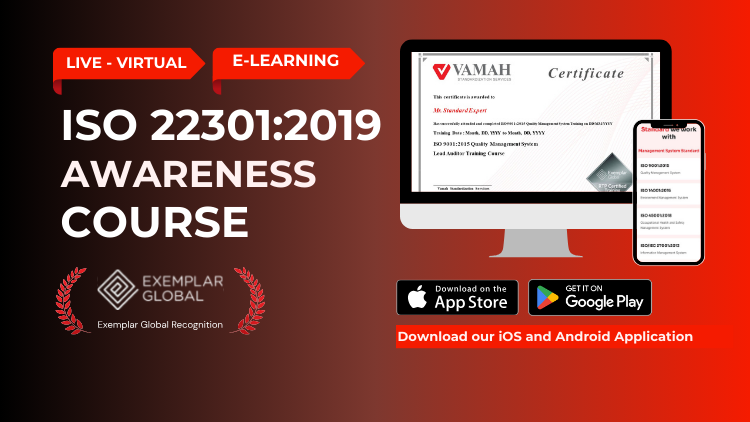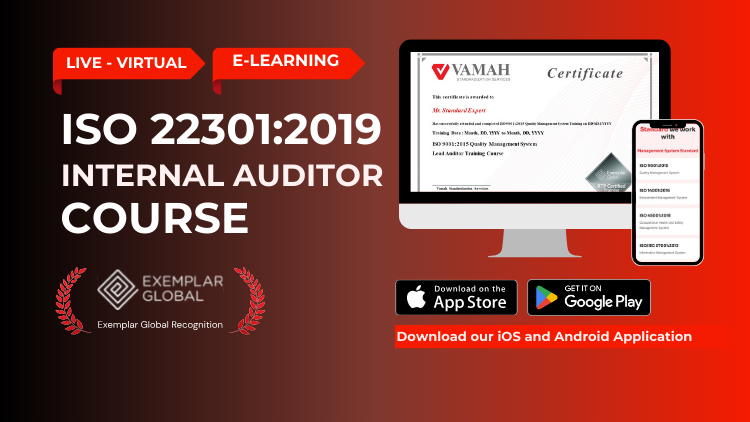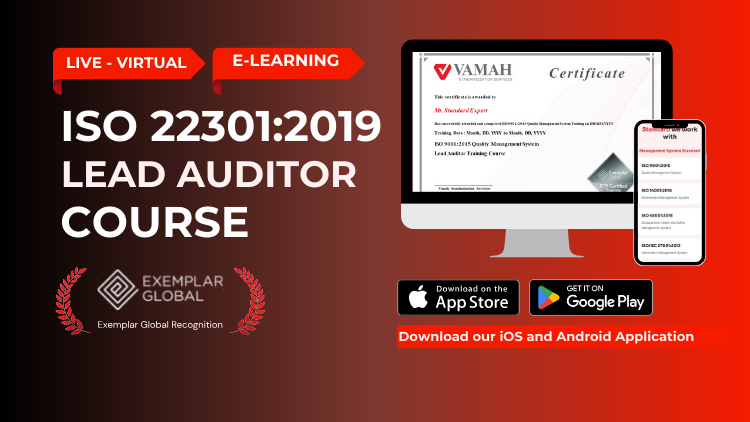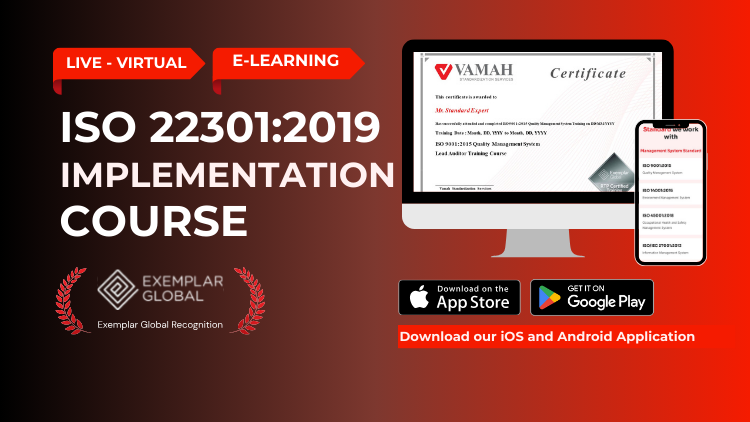ISO 22301:2019
ISO 22301:2019 is the international standard for Business Continuity Management Systems (BCMS). It provides a framework for organizations to prepare for, respond to, and recover from disruptive incidents. The standard is designed to help organizations ensure they can continue to operate during disruptions and recover effectively, thereby safeguarding their interests and maintaining operational resilience.
Trainings
Our trainings are developed for ISO 22301:2019 with various level such as Awareness, Internal Auditor, Lead Auditor and Implementation.
ISO 22301:2019 Awareness Training
Our Awareness Training introduces participants to the fundamentals of ISO 22301:2019.
This course covers the importance of business continuity management, the key principles of the ISO 22301 standard, and the benefits of implementing a BCMS.
It is ideal for employees at all levels who need a basic understanding of business continuity.

ISO 22301:2019 Internal Auditor Training
Our Internal Auditor Training is designed for individuals who will conduct internal audits of their organization’s BCMS.
This course provides detailed knowledge of the audit process, including planning, executing, reporting, and following up on audits.
Participants will learn how to evaluate the effectiveness of their BCMS and identify areas for improvement to ensure ongoing compliance with ISO 22301:2019 requirements.

ISO 22301:2019 Lead Auditor Training
Our Lead Auditor Training is intended for professionals seeking to become certified lead auditors.
This comprehensive course covers advanced auditing techniques, audit planning and execution, and the principles of ISO 19011, the international standard for auditing management systems.
Participants will gain the expertise needed to lead successful audits and drive continuous improvement within their organizations as per ISO 22301:2019.

ISO 22301:2019 Implementation Training
Our Implementation Workshop offers hands-on guidance for organizations in the process of implementing ISO 22301:2019.
This workshop covers the development of essential documentation, including business continuity plans, risk assessments, and response strategies.
Participants will learn how to integrate ISO 22301 requirements into their existing processes and ensure a smooth transition to a certified BCMS.

DIY Templates
- Cost-Effective: Save on consultancy fees.
- Time-Saving: Ready-made documents for quick implementation.
- Comprehensive: Includes all necessary documents.
- Customizable: Easily adapt to your organization’s needs.
- Expertly Crafted: Developed by industry professionals.
- Streamlined Process: Clear instructions reduce the learning curve for team members.
Implement ISO 22301:2019 with DIY Templates
At Vamah Standardization Services LLP, we provide a range of ISO 22301:2019 DIY templates to facilitate the implementation of Business Continuity Management Systems.
Our templates include comprehensive documents such as business continuity plans, risk assessment reports, response strategies, and recovery procedures. These resources are designed to help organizations achieve ISO 22301 certification efficiently and cost-effectively.
ISO 22301:2019 Consultancy
At VamahSS, we assist organizations in navigating the complexities of ISO standards implementation, certification, and continual improvement. Recognizing that every organization is unique, we provide tailored solutions to fit specific needs, making us your trusted partner in achieving ISO certification. Whether starting your ISO journey or optimizing existing processes, our consultancy services are designed to meet your objectives.We offer remote ISO consultancy services for various management system standards and accreditation standards. Choose between our two consulting options: online workshops or full project support tailored to your requirements. Contact us today to start your path to ISO certification.
Contact Us
Business Continuity Management System
ISO 22301:2019 is the international standard for Business Continuity Management Systems (BCMS). It provides a framework for organizations to prepare for, respond to, and recover from disruptive incidents. This guide provides a comprehensive overview of ISO 22301, its importance, implementation process, and business impact.
What is ISO 22301?
Why is ISO 22301 Important?
Why is ISO 22301 Important?
1. Enhances Resilience
2. Structured Approach
3. Protects Interests
4. Maintains Operational Performance
5. Meets Regulatory and Contractual Obligations
6. Improves Risk Management
7. Competitive Advantage
8. Continuous Improvement
What is Current Version of ISO 22301 Standard?
What is a BCMS?
Clause 4: Context of the Organization
Clause 5: Leadership
Clause 6: Planning
Clause 7: Support
Clause 8: Operation
Clause 9: Performance Evaluation
Clause 10: Improvement
ISO 22301:2019 provides a comprehensive framework for establishing, implementing, and maintaining an effective Business Continuity Management System (BCMS). By following its structured approach, organizations can enhance their resilience, ensure operational continuity, and meet regulatory and contractual obligations.
The standard's emphasis on leadership, planning, support, operation, performance evaluation, and continuous improvement ensures that organizations are well-prepared to manage disruptions and safeguard their interests.
Implementing ISO 22301:2019 not only improves organizational resilience but also demonstrates a commitment to maintaining high standards of business continuity management.
-1.png?width=808&height=197&name=vamah(1)-1.png)